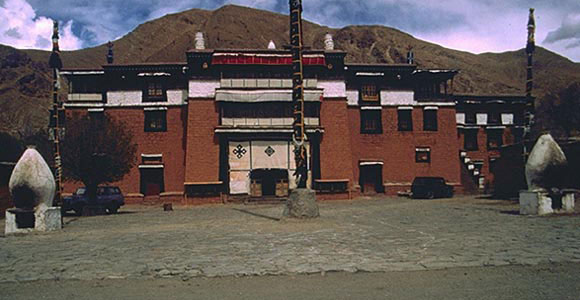
Gonggar Choede monastery, which was built in 1464, belongs to the Zung branch (meaning grey earth ) of the Sakyapa school of Tibetan Buddhism. The principal founder of the Dzongpa Tradition was Dorje Chang Kunga Namgyal (1432–1496). The main monastery of the Dzongpa is Gongkar Chode just south-west of Lhasa on the south side of the Tsangpo River at the distance of 55Km from Lhasa.
In the 16th century, the monastery was beautified with wall paintings of the Khyenri school of Tibetan paintings done by the well-known artist of the times, Jamyang Khyentse Wangchuk
The history of the monastery is traced to the first visit of Jowo-je Palden Atisha (980–1054 CE), Buddhist teacher from the Pala Empire. During his first visit, Atisha had stopped close to the location of the monastery, prostrated in the direction of the monastery and prophesised that one day a monastery would be built at this location, which would become famous. He had marked the location with a mound of white pebbles in the form of a Mandala (this mound got destroyed during the Cultural Revolution). The Dzong was under the stewardship of Dorje-denpa Kun-ga Namgyal also known as Dorje Chang Kunga Namgyal (1432–1496), who was a well-known Guru who had received training in the Sutra, Tantra and Tantric rituals from masters of all traditions. He was the holder of the Dzongpa tradition of the Sakyapa school of Tibetan Bhuddism. When he was sitting on the roof of his house in the Gongkar Dzong, while reciting the religious scripture, the Vajradhatu, a leaf of the scripture was flown away by wind and it fell at a location where the present Gongkar Choede Monastery is located.
It is mentioned that between Gongkar and Tsetang there are seven gompas of the Sakyapa sect, including the Gongkar Dorjeden, known as Gongar Choede, the pillar of Sakyapa power, to the south of the Tsongpo valley.
Gonggar Choede monastery is three storey’s high and the assembly hall is dedicated to the old paintings and three big statues of Sakya Pendita, Shakyamuni and Guru Rinpoche. The monastery survived many beautiful old wall painting date back to the 16th Century. It is worthwhile to spend some time with torch to explore the wall painting both in the main assembly hall and on the second floors.
The Gongkar Monastery also became famous because it was here that the artistic Central Tibetan painting of Kyenri originated.